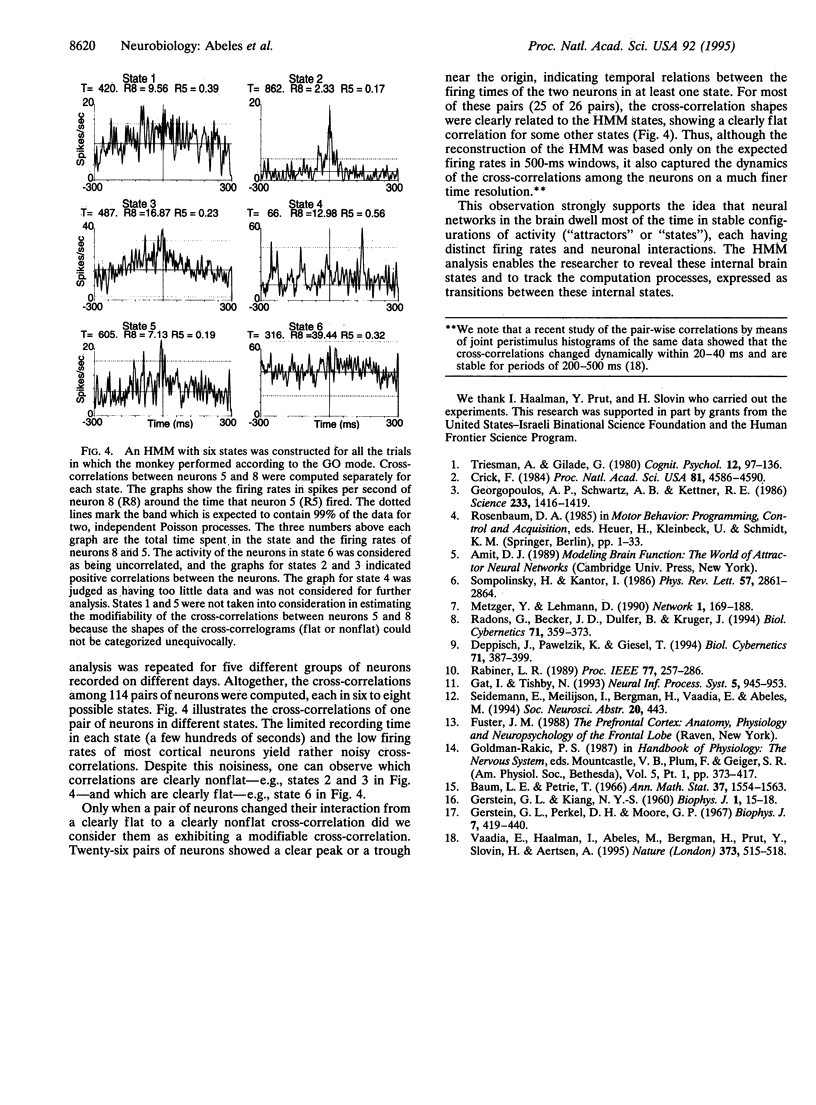Abstract
Parallel recordings of spike trains of several single cortical neurons in behaving monkeys were analyzed as a hidden Markov process. The parallel spike trains were considered as a multivariate Poisson process whose vector firing rates change with time. As a consequence of this approach, the complete recording can be segmented into a sequence of a few statistically discriminated hidden states, whose dynamics are modeled as a first-order Markov chain. The biological validity and benefits of this approach were examined in several independent ways: (i) the statistical consistency of the segmentation and its correspondence to the behavior of the animals; (ii) direct measurement of the collective flips of activity, obtained by the model; and (iii) the relation between the segmentation and the pair-wise short-term cross-correlations between the recorded spike trains. Comparison with surrogate data was also carried out for each of the above examinations to assure their significance. Our results indicated the existence of well-separated states of activity, within which the firing rates were approximately stationary. With our present data we could reliably discriminate six to eight such states. The transitions between states were fast and were associated with concomitant changes of firing rates of several neurons. Different behavioral modes and stimuli were consistently reflected by different states of neural activity. Moreover, the pair-wise correlations between neurons varied considerably between the different states, supporting the hypothesis that these distinct states were brought about by the cooperative action of many neurons.
Full text
PDF




Selected References
These references are in PubMed. This may not be the complete list of references from this article.
- Crick F. Function of the thalamic reticular complex: the searchlight hypothesis. Proc Natl Acad Sci U S A. 1984 Jul;81(14):4586–4590. doi: 10.1073/pnas.81.14.4586. [DOI] [PMC free article] [PubMed] [Google Scholar]
- Deppisch J., Pawelzik K., Geisel T. Uncovering the synchronization dynamics from correlated neuronal activity quantifies assembly formation. Biol Cybern. 1994;71(5):387–399. doi: 10.1007/BF00198916. [DOI] [PubMed] [Google Scholar]
- GERSTEIN G. L., KIANG N. Y. An approach to the quantitative analysis of electrophysiological data from single neurons. Biophys J. 1960 Sep;1:15–28. doi: 10.1016/s0006-3495(60)86872-5. [DOI] [PMC free article] [PubMed] [Google Scholar]
- Georgopoulos A. P., Schwartz A. B., Kettner R. E. Neuronal population coding of movement direction. Science. 1986 Sep 26;233(4771):1416–1419. doi: 10.1126/science.3749885. [DOI] [PubMed] [Google Scholar]
- Perkel D. H., Gerstein G. L., Moore G. P. Neuronal spike trains and stochastic point processes. II. Simultaneous spike trains. Biophys J. 1967 Jul;7(4):419–440. doi: 10.1016/S0006-3495(67)86597-4. [DOI] [PMC free article] [PubMed] [Google Scholar]
- Radons G., Becker J. D., Dülfer B., Krüger J. Analysis, classification, and coding of multielectrode spike trains with hidden Markov models. Biol Cybern. 1994;71(4):359–373. doi: 10.1007/BF00239623. [DOI] [PubMed] [Google Scholar]
- Sompolinsky H, Kanter I., I Temporal association in asymmetric neural networks. Phys Rev Lett. 1986 Dec 1;57(22):2861–2864. doi: 10.1103/PhysRevLett.57.2861. [DOI] [PubMed] [Google Scholar]
- Treisman A. M., Gelade G. A feature-integration theory of attention. Cogn Psychol. 1980 Jan;12(1):97–136. doi: 10.1016/0010-0285(80)90005-5. [DOI] [PubMed] [Google Scholar]
- Vaadia E., Haalman I., Abeles M., Bergman H., Prut Y., Slovin H., Aertsen A. Dynamics of neuronal interactions in monkey cortex in relation to behavioural events. Nature. 1995 Feb 9;373(6514):515–518. doi: 10.1038/373515a0. [DOI] [PubMed] [Google Scholar]


